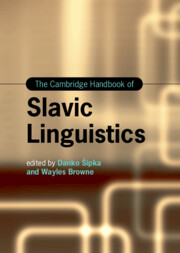Book contents
- The Cambridge Handbook of Slavic Linguistics
- Cambridge Handbooks in Language and Linguistics
- The Cambridge Handbook of Slavic Linguistics
- Copyright page
- Contents
- Figures
- Tables
- Contributors
- Introduction
- Part 1 Prosody and Phonology
- Part 2 Inflectional and Derivational Morphology
- Part 3 Syntax
- Part 4 Lexicon
- Part 5 Sociolinguistic and Geographical Approaches
- Part 6 Experimental and Quantitative Approaches
- 34 Psycholinguistics and Language Acquisition
- 35 Natural Language Processing
- Name Index
- Subject Index
- References
34 - Psycholinguistics and Language Acquisition
from Part 6 - Experimental and Quantitative Approaches
Published online by Cambridge University Press: 16 May 2024
- The Cambridge Handbook of Slavic Linguistics
- Cambridge Handbooks in Language and Linguistics
- The Cambridge Handbook of Slavic Linguistics
- Copyright page
- Contents
- Figures
- Tables
- Contributors
- Introduction
- Part 1 Prosody and Phonology
- Part 2 Inflectional and Derivational Morphology
- Part 3 Syntax
- Part 4 Lexicon
- Part 5 Sociolinguistic and Geographical Approaches
- Part 6 Experimental and Quantitative Approaches
- 34 Psycholinguistics and Language Acquisition
- 35 Natural Language Processing
- Name Index
- Subject Index
- References
Summary
Past review articles on the state-of-the-art of Slavic psycholinguistics and language acquisition in monolingual and heritage bilingual Slavic speakers serve as the starting point for this chapter. We discuss the present state of the field regarding methodological advances and current topics (gender, case, pronominal objects, aspect, and relative clauses), then briefly identify emerging trends in psycholinguistic infrastructure, such as conducting experiments remotely and sharing resources in open access repositories. Our survey highlights the increased popularity of investigations of language processing in real-time and large-scale cross-linguistic studies. We conclude that the field of Slavic psycholinguistics and language acquisition is gaining new and exciting momentum.
Keywords
- Type
- Chapter
- Information
- The Cambridge Handbook of Slavic Linguistics , pp. 717 - 731Publisher: Cambridge University PressPrint publication year: 2024



